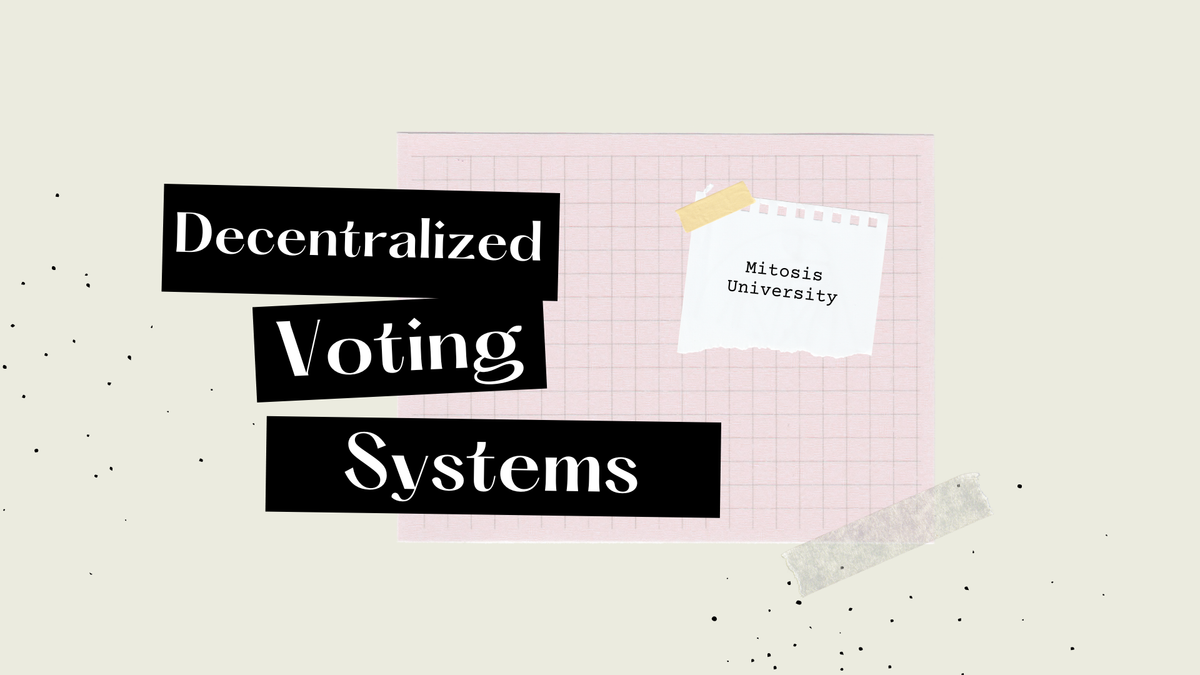Decentralized Voting Systems

Introduction
Voting is a cornerstone of democratic societies, enabling citizens to participate in decision-making and shape their communities and nations. Traditional voting systems, often centralized and reliant on physical infrastructure, face challenges such as fraud, tampering, low voter turnout, and high operational costs. Decentralized voting systems, powered by blockchain technology, offer a transformative solution by providing a secure, transparent, and accessible platform for casting votes.
Background and Definition
Decentralized voting systems leverage blockchain technology, a distributed ledger that records transactions across multiple nodes without a central authority. Each vote is recorded as a transaction on the blockchain, which is immutable and transparent, ensuring that once cast, it cannot be altered or tampered with. This contrasts with traditional centralized systems, where a single entity controls the voting process, potentially introducing risks of manipulation.
Key platforms include Follow My Vote, Voatz, Polyas, Polys, and Agora, which aim to make voting more accessible by enabling online participation and reducing reliance on physical polling stations.
Security Features
Security is a cornerstone of decentralized voting systems, inheriting blockchain's robust properties:
- Decentralization: Distributing control across nodes eliminates single points of failure, making manipulation difficult. This is supported by cryptographic security, ensuring votes are encrypted and only accessible to authorized parties.
- Immutability: Once recorded, votes cannot be altered, ensuring the integrity of the electoral process. Consensus mechanisms like Proof of Work (PoW) or Proof of Stake (PoS) validate transactions, with PoS being explored for energy efficiency.
- Cryptographic Techniques: Zero-knowledge proofs (ZKPs) and homomorphic encryption allow verification without revealing voter identities, addressing privacy concerns. Research highlights security as a benefit in 224 papers, but also a challenge (rank 2) due to cyberattacks and smart contract vulnerabilities.
Challenges include scalability, with Hyperledger Fabric offering 3500 transactions per second but still needing optimization for national elections. Privacy protection is another concern, as the public ledger could expose voter patterns, though techniques like ring signatures mitigate this. Denial-of-service (DoS) attacks pose risks, with some systems like OVN being susceptible without third-party auditing
Transparency Mechanisms
Transparency is an undisputed benefit. The public nature of the blockchain allows anyone to verify votes and the tallying process, enhancing trust. End-to-end verifiability enables voters to check if their vote was recorded and counted correctly, a feature supported by systems like Follow My Vote and Voatz.
This transparency is achieved through the immutable ledger, where any attempt to alter votes would be detectable, ensuring auditability. However, balancing transparency with privacy is crucial, as the public ledger must not reveal voter identities. Advanced cryptographic methods, such as zero-knowledge proofs, ensure verification without compromising anonymity, addressing potential concerns about voter data exposure.
Impact on Civic Engagement
Decentralized voting systems have the potential to significantly enhance civic engagement by making voting more accessible and trustworthy:
- Increased Accessibility: Online voting allows remote participation, potentially increasing turnout, especially for voters abroad or with mobility issues. Research shows accessibility, with future work including mobile voting modules and options for disabled voters. Systems like Polys demonstrate success in community elections, improving engagement by providing secure platforms.
- Building Trust: Transparency and verifiability can restore confidence in electoral processes, encouraging participation. For example, VoteChain, developed for Palestine, ensures equal participation rights and broad voter inclusion, potentially increasing civic engagement through inclusivity.
- Cost-Effectiveness: Eliminating physical polling stations reduces costs, which can be redirected to civic education, further boosting participation.
However, challenges include public acceptance, with complexity potentially hindering adoption. Educational campaigns are suggested to build trust, and resistance from political leaders wary of decentralization could impact engagement. Research indicates that usability and acceptability are critical for widespread adoption.
Case Studies and Practical Applications
Practical implementations highlight the potential of decentralized voting systems:
- Follow My Vote: Published a seminal paper in 2014, focusing on a verifiable and transparent voting system to reduce fraud, igniting further research.
- Voatz: Offers a mobile voting platform, leveraging blockchain for vote integrity, particularly useful for remote elections.
- Polyas: Provides solutions for organizational voting, ensuring secure and transparent processes.
- Polys: Used in student councils and unions, enhancing community productivity and engagement.
- VoteChain: Developed for Palestine, VoteChain uses Ethereum’s decentralized architecture to ensure no single entity can control the system, preventing tampering and reducing risks associated with central points of failure, with performance testing showing capability for national elections with high voter turnout.
These examples illustrate how decentralized systems can be applied in diverse contexts, from local community votes to national elections, showcasing their versatility.
Challenges and Future Directions
Despite their promise, several challenges remain:
- Scalability: Current blockchain technologies struggle with large-scale elections, with Bitcoin processing 4.6 to 7 transactions per second and Ethereum 15, while Hyperledger Fabric offers 3500. Solutions like layer 2 and sharding are being explored.
- Privacy Concerns: Maintaining voter privacy is crucial, with techniques like ring signatures and zero-knowledge proofs being developed to address public ledger exposure risks.
- Energy Consumption: PoW consensus mechanisms are energy-intensive, raising environmental concerns. Alternatives like PoS, used in 6 papers for consensus, are being explored for efficiency.
- Public Acceptance: Convincing voters and officials requires education and successful pilot projects, with 88 papers lacking clear future work statements, indicating a need for further research.
Prospects are promising, with advancements in Ethereum (34.91% of platforms) and new cryptographic techniques like ZKPs and homomorphic encryption enhancing security and privacy. Pilot projects and research continue to refine these systems, potentially leading to widespread adoption in national elections.
Conclusion
Decentralized voting systems offer a transformative approach to electoral processes, enhancing security, transparency, and civic engagement. By leveraging blockchain technology, they address many limitations of traditional systems, providing a more trustworthy and accessible way to participate in democracy. However, challenges like scalability, privacy, and public acceptance must be addressed through continued research and implementation. As technology evolves, these systems could play a pivotal role in modernizing democracy, ensuring every vote is counted accurately and reflecting the will of the people.
References
- Blockchain for Electronic Voting System—Review and Open Research Challenges
- Decentralizing Democracy: Secure and Transparent E-Voting Systems with Blockchain Technology in the Context of Palestine
- Enhancing Security and Transparency in Online Voting through Blockchain Decentralization
- Follow My Vote official website
- Voatz official website
- Polyas official website
- Polys official website
- Agora official website
MITOSIS official links:
GLOSSARY
Mitosis University
WEBSITE
X (Formerly Twitter)
DISCORD
DOCS


Comments ()